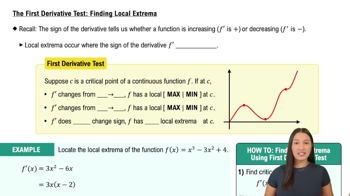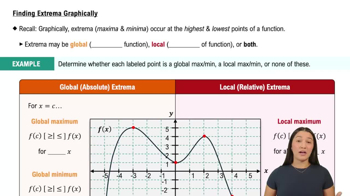Table of contents
- 0. Functions7h 52m
- Introduction to Functions16m
- Piecewise Functions10m
- Properties of Functions9m
- Common Functions1h 8m
- Transformations5m
- Combining Functions27m
- Exponent rules32m
- Exponential Functions28m
- Logarithmic Functions24m
- Properties of Logarithms34m
- Exponential & Logarithmic Equations35m
- Introduction to Trigonometric Functions38m
- Graphs of Trigonometric Functions44m
- Trigonometric Identities47m
- Inverse Trigonometric Functions48m
- 1. Limits and Continuity2h 2m
- 2. Intro to Derivatives1h 33m
- 3. Techniques of Differentiation3h 18m
- 4. Applications of Derivatives2h 38m
- 5. Graphical Applications of Derivatives6h 2m
- 6. Derivatives of Inverse, Exponential, & Logarithmic Functions2h 37m
- 7. Antiderivatives & Indefinite Integrals1h 26m
- 8. Definite Integrals4h 44m
- 9. Graphical Applications of Integrals2h 27m
- 10. Physics Applications of Integrals 2h 22m
5. Graphical Applications of Derivatives
Intro to Extrema
Problem 4.3.44
Textbook Question
Increasing and decreasing functions. Find the intervals on which f is increasing and the intervals on which it is decreasing.
f(x) = tan⁻¹ (x/(x²+2))
 Verified step by step guidance
Verified step by step guidance1
First, understand that to determine where the function f(x) is increasing or decreasing, we need to find its derivative, f'(x). This will help us identify the critical points and analyze the behavior of the function.
Calculate the derivative f'(x) using the chain rule and quotient rule. The function f(x) = tan⁻¹(u) where u = x/(x²+2). The derivative of tan⁻¹(u) with respect to x is 1/(1+u²) * du/dx.
Apply the quotient rule to find du/dx for u = x/(x²+2). The quotient rule states that if u = v/w, then du/dx = (v'w - vw')/w². Here, v = x and w = x²+2.
Simplify the expression for f'(x) using the derivative found in the previous step. This involves substituting du/dx into the derivative of tan⁻¹(u) and simplifying the expression.
Determine the intervals where f'(x) > 0 (function is increasing) and f'(x) < 0 (function is decreasing). This involves solving inequalities and considering the critical points where f'(x) = 0 or is undefined.
 Verified video answer for a similar problem:
Verified video answer for a similar problem:This video solution was recommended by our tutors as helpful for the problem above
Video duration:
9mPlay a video:
Was this helpful?
Key Concepts
Here are the essential concepts you must grasp in order to answer the question correctly.
Derivative
The derivative of a function measures the rate at which the function's value changes as its input changes. It is a fundamental tool in calculus used to determine the slope of the tangent line to the curve at any point. For a function to be increasing, its derivative must be positive, while a negative derivative indicates that the function is decreasing.
Recommended video:

Derivatives
Critical Points
Critical points occur where the derivative of a function is either zero or undefined. These points are essential for analyzing the behavior of the function, as they can indicate potential local maxima, minima, or points of inflection. To determine intervals of increase or decrease, one must evaluate the derivative at these critical points and test the sign of the derivative in the intervals created by these points.
Recommended video:

Critical Points
First Derivative Test
The First Derivative Test is a method used to determine whether a function is increasing or decreasing on specific intervals. By examining the sign of the derivative before and after each critical point, one can conclude whether the function transitions from increasing to decreasing or vice versa. This test provides a systematic approach to identifying the intervals of increase and decrease for a given function.
Recommended video:

The First Derivative Test: Finding Local Extrema

 5:58m
5:58mWatch next
Master Finding Extrema Graphically with a bite sized video explanation from Callie
Start learning





